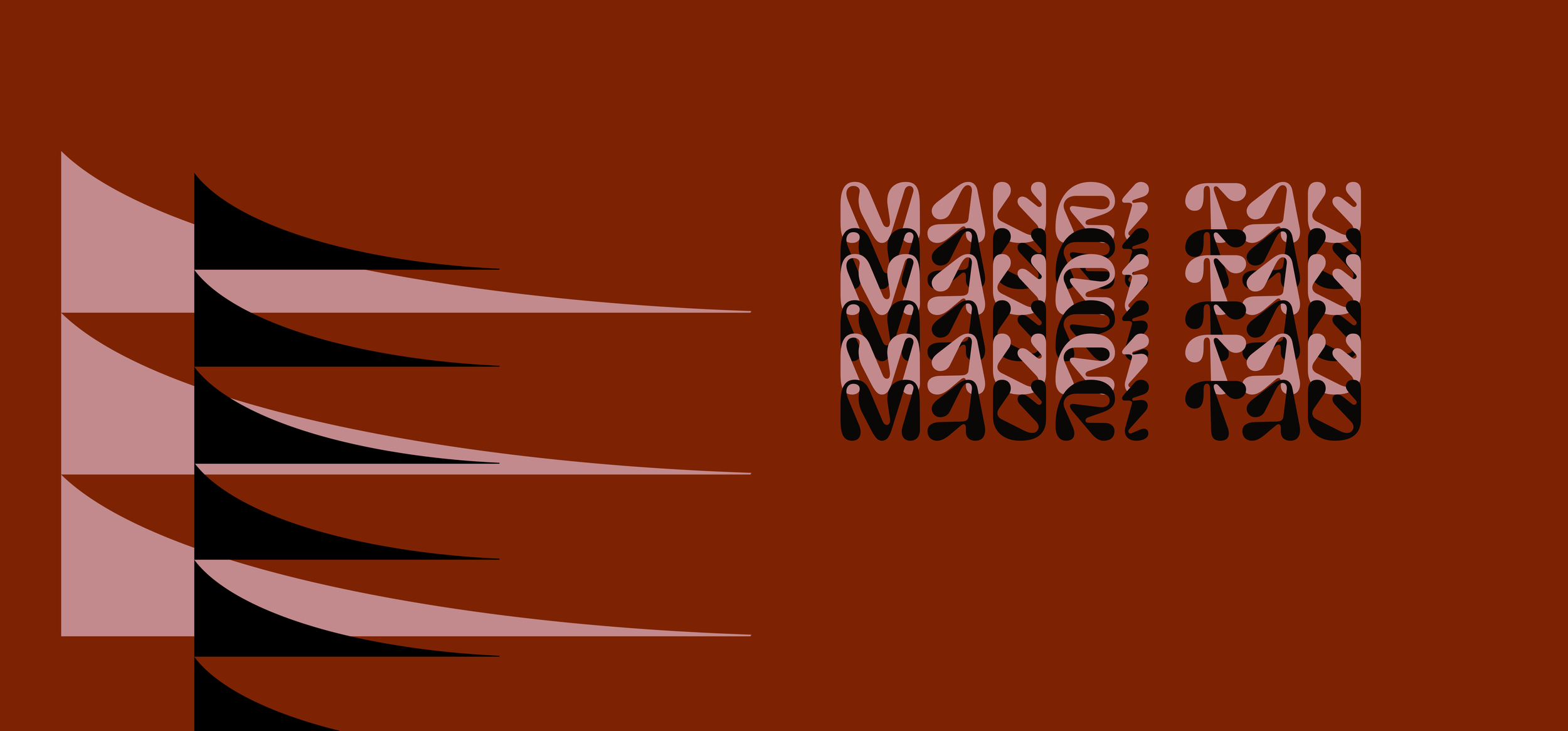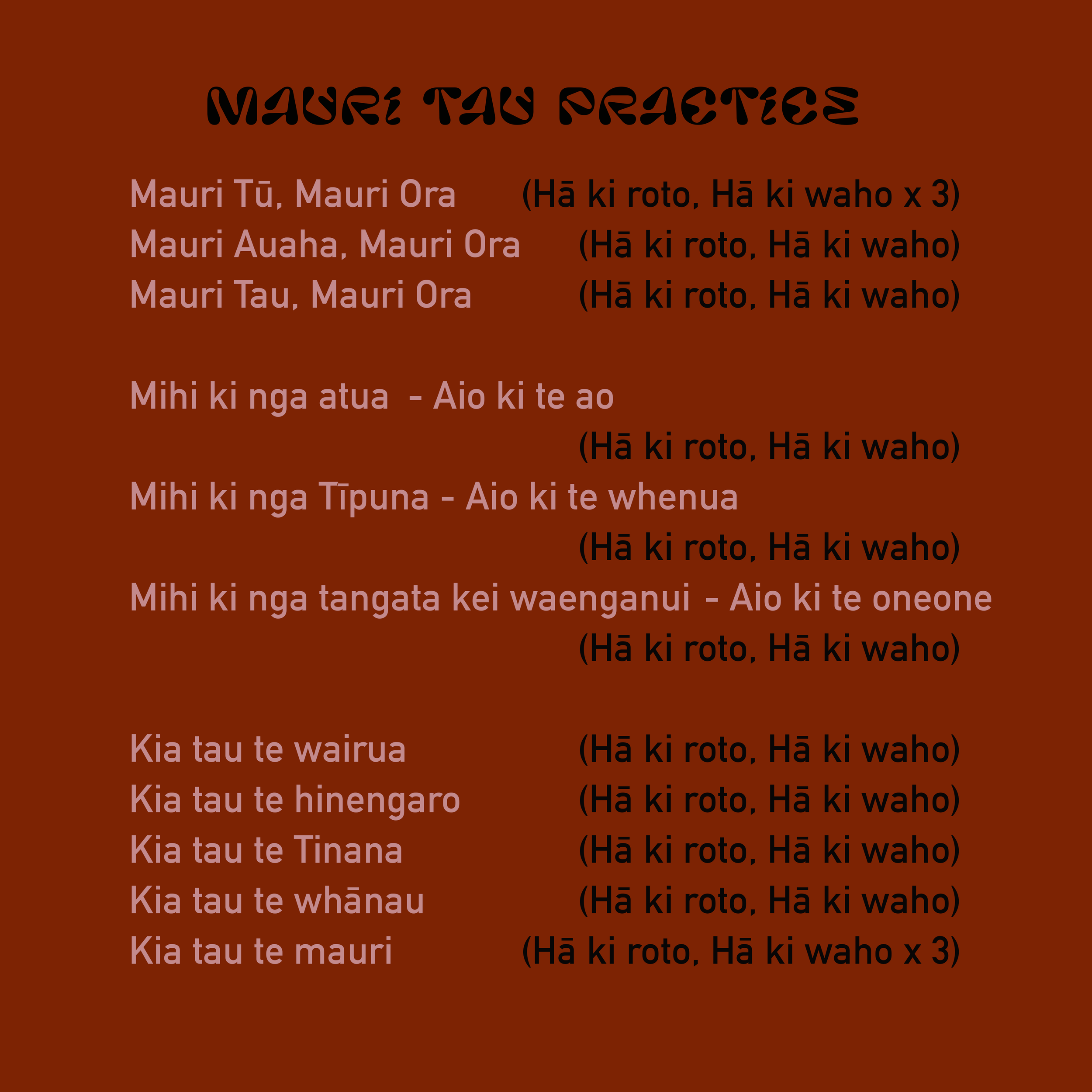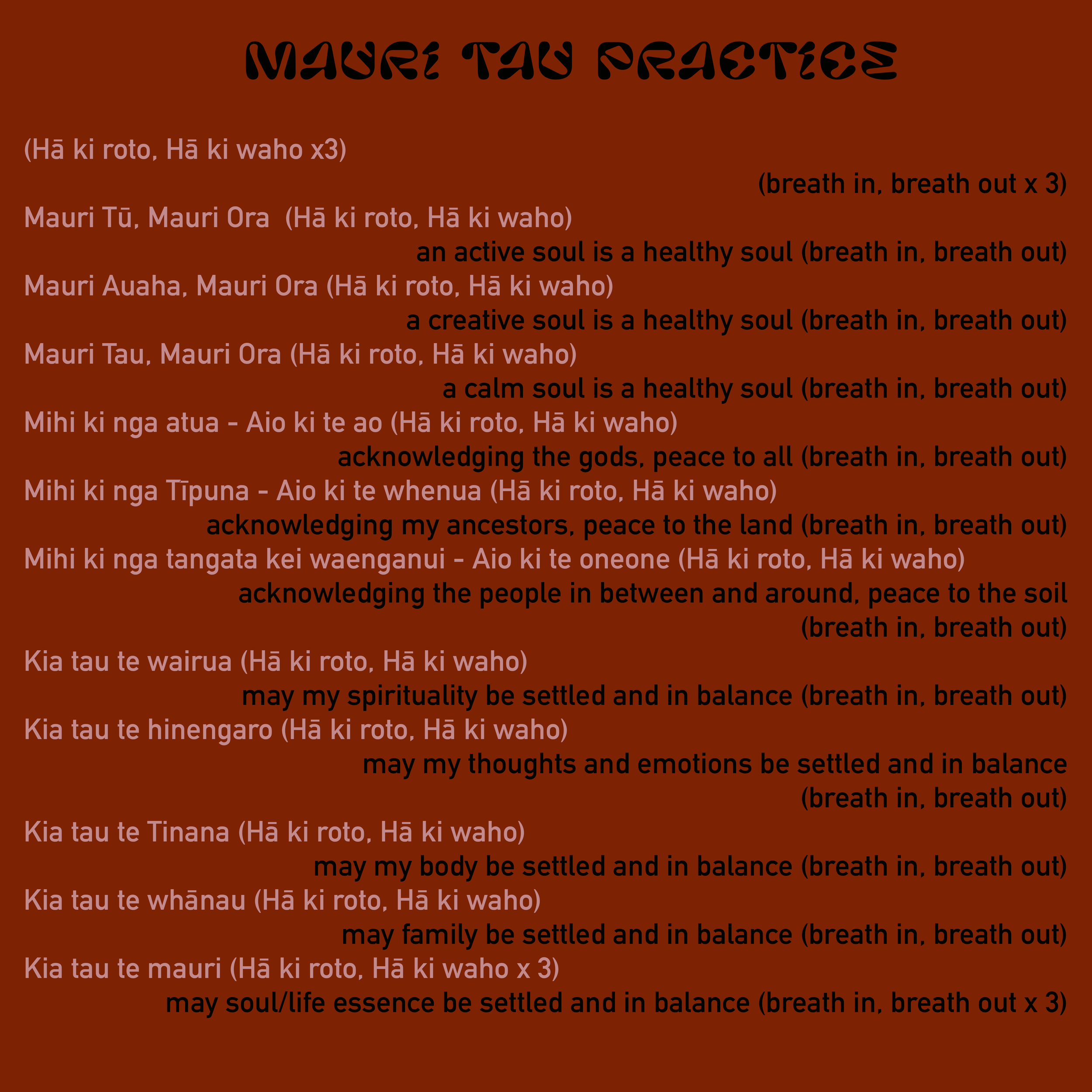
A MAURI TAU PRACTICE
NĀ JESSICA GERBIC
Below is a Mauri Tau practice devised by Dr Jessica Gerbic (Ngāti Pūkenga, Ngāti Pikiao). Its purpose is to help you ground, relax, and rest. Jessica has also written a personal essay for us on the topic of Mauri Tau, which you can read here.
I have created a Mauri tau practice to whakapiki hauora. It captures and reflects my own experience reconnecting to my whenua in Tauranga. It draws on the practice of ngāngā a crucial component of Mauri tau, as the breath can cleanse your tinana. When we breathe in, especially into our puku we are breathing into a significant area. Our puku is the whare of emotions, holds kai to nourish us, our pito is located there and its close to our whare tangata for wāhine.
The below piece could be used when out harvesting, before or after mixing or creating with your pigments – it is the one I use with my kōtiro when we need to find a place of tau. Having the physical element of pigments to touch, feel and see will deepen your wairua experience by having a physical element to help keep you connected.
In making and creating with the pigments I sourced from Tauranga, I further began to lean into other experiences of Mauri tau. Focusing on what helps me find a sense of balance, connection and expression. In bringing attention to the pigments beyond their physical existence I have been able to explore further layers to their identity in relation to mine. To me they have provided a greater understanding of my pēpēha because when I name my maunga now, I can also describe the feel of the oneone, the weight, the grit, and the colours. When I mention my moana, I know the shapes of the shells that wash ashore that hold my pigments. I am familiar with how my awa flows, softens and blends pigments. I know the hauora of the taiao. I am familiar with the scars of the rākau where the gum dripped, and the manu that sung to me when I visited. So, I can link their whakapapa to my own when I use these pigments to make artwork. An interwoven creation that brings my whakapapa to life - a visual representation of my Māoritanga.
The methodical nature of in which we gather and create with pigments allows me to experience an intimate relationship with each resource. When you notice and pay attention to what you can physically, touch, see, hear, and feel you are recognizing this connection.
MAURI TAU PRACTICE:
(Hā ki roto, Hā ki waho x3)
Mauri Tū, Mauri Ora (Hā ki roto, Hā ki waho)
Mauri Auaha, Mauri Ora (Hā ki roto, Hā ki waho)
Mauri Tau, Mauri Ora (Hā ki roto, Hā ki waho)
Mihi ki nga atua - Aio ki te ao (Hā ki roto, Hā ki waho)
Mihi ki nga Tīpuna - Aio ki te whenua (Hā ki roto, Hā ki waho)
Mihi ki nga tangata kei waenganui - Aio ki te oneone (Hā ki roto, Hā ki waho)
Kia tau te wairua (Hā ki roto, Hā ki waho)\
Kia tau te hinengaro (Hā ki roto, Hā ki waho)
Kia tau te Tinana (Hā ki roto, Hā ki waho)
Kia tau te whānau (Hā ki roto, Hā ki waho)
Kia tau te mauri (Hā ki roto, Hā ki waho x 3)
TRANSLATION OF MAURI TAU PRACTICE:
(breath in breath out x 3)
An active soul is a healthy soul (breath in, breath out)
A creative soul is a healthy soul (breath in, breath out)
A calm soul is a healthy soul (breath in, breath out)
Acknowledging the gods, peace to all (breath in, breath out)
Acknowledging my ancestors, peace to the land (breath in, breath out)
Acknowledging the people in between and around, peace to the soil (breath in, breath out)
May my spirituality be settled and in balance (breath in, breath out)
May my thoughts and emotions be settled and in balance (breath in, breath out)
May my body be settled and in balance (breath in, breath out)
May family be settled and in balance (breath in, breath out)
May soul/life essence be settled and in balance (breath in, breath out x 3)
I have some patai below to help settle your mauri and engage with your sense’s next time you source, make and create with oneone.
1. What can you see? The colours, shades, textures, or shape? Who and what does this remind you of?
2. What can I feel? Is it hard, soft, wet, dry – what is the texture?
3. How does it make me feel? What emotions, thoughts or experiences do you have as you source or create?
4. What can you smell? Is it familiar, new, earthy, fresh?
5. How are you breathing? Is it slow, deep, shallow – draw some more breaths and pay attention.
6. What else can you notice around you? What do you feel drawn to? What have you not seen before?
7. What does this represent to you? About you? For you?
Some ideas to help learn and familiarise yourself with the kupu in a piece like this MAURI TAU practice could include:
Taking a photo of the exercise to read when you’re ready or when its needed
Putting actions to the kupu
Creating a ritual around it (i.e., visiting a special place)
Finding your rhythm with the kupu (i.e., slow, chanted, or sung)
Make a recording of you or someone’s voice you find tau reciting this – then you can play it when needed and connect to the kupu.
Reading a line at a time, then repeating it without looking
Memorizing a new line one at a time and slowly building on
Visualising places, people, or images in your mind when you say the kupu.
I put a karanga out to those who feel depleted, unsure how to whakahauora, scared to return home, who feel daunted by the thought of visiting their tūrangawaewae. Find solace and comfort in the taiao your tīpuna once resided. Your whakapapa will take on a new meaning which will in turn enhance your Māoritanga. When visiting, feel the oneone, collect the resources you need both physically and spiritually. Release what you need into the taiao. I want to acknowledge that for some, stepping into one’s whakapapa via interacting with whānau, hapu and iwi can be daunting or simply not an option for a variety of reasons. I adore this part of oneone because it provides a pathway to connect to your whakapapa that is discrete and can take place at your own pace.


Dr. Jessica Gerbic is a Māori wahine born and raised in Tāmaki Makaurau. She is of mixed whakapapa from Ngāti Pūkenga, Ngāti Pikiao, Dalmatian and Irish decent. She lives with her husband and 7 month pēpē. Jessica works as a Clinical Psychologist in public mental health, runs Pūkenga Psychology where she sees clients and sells indigenous resources focuseed on hauora.
